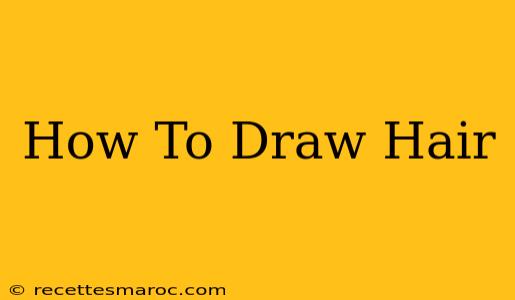Drawing realistic and expressive hair can be a challenging, yet incredibly rewarding, aspect of art. Whether you're a beginner picking up a pencil for the first time or a seasoned artist looking to refine your technique, this guide will walk you through the essential steps and techniques to master the art of drawing hair. We'll cover everything from understanding the basic structure to achieving dynamic movement and texture.
Understanding the Fundamentals of Hair Structure
Before diving into specific techniques, it's crucial to grasp the underlying structure of hair. Hair isn't just a single, uniform mass; it's composed of individual strands that clump together in various ways. Understanding this will allow you to create more believable and lifelike representations.
Key Considerations:
- Hair Growth Pattern: Hair grows from the scalp in specific directions. Observe how hair parts, flows over the head, and falls around the face. Understanding this natural pattern is key to creating realistic hairstyles.
- Hair Volume and Density: Consider the thickness and density of the hair you're drawing. Thick, dense hair will have a different appearance than thin, sparse hair. This influences the shading and overall texture you'll need to depict.
- Hair Type: Different hair types (straight, wavy, curly, kinky) have distinct characteristics. Straight hair hangs smoothly, while curly hair forms distinct spirals and coils. Observe and study these variations to accurately portray different hair types.
Mastering Basic Drawing Techniques for Hair
Now that we've established the foundational understanding, let's move on to the drawing techniques themselves.
1. Starting with Simple Shapes:
Begin by sketching the overall shape of the hairstyle using simple forms like ovals, cylinders, and curves. This helps establish the basic structure before adding details.
2. Blocking in Hair Sections:
Divide the hair into distinct sections or clumps. This helps you control the flow and direction of the strands, making it easier to render the overall form.
3. Adding Individual Strands:
Gradually add individual strands within each section. Vary the thickness and length of these strands to create a natural and dynamic look. Avoid drawing every single strand; instead, focus on suggesting individual strands to avoid a monotonous appearance.
4. Utilizing Shading and Value:
Shading is crucial for creating depth and dimension in your hair drawings. Use varying values of light and shadow to define the form, creating highlights and shadows to suggest volume and texture. Pay close attention to where light hits the hair to emphasize the shape and form.
5. Experiment with Different Textures:
Practice drawing different hair textures, such as straight, wavy, curly, or kinky. Each texture requires a different approach to shading and linework.
Advanced Techniques for Realistic Hair
Once you’ve mastered the basics, you can explore more advanced techniques to create even more realistic and expressive hair.
1. Using Reference Images:
Always use reference images when possible. Observing real hair and hairstyles will help you understand the nuances of light, shadow, and texture.
2. Understanding Light and Shadow:
Mastering light and shadow is key to creating realistic hair. Observe how light interacts with hair, creating highlights, mid-tones, and shadows.
3. Adding Details:
Once you've established the basic form and shading, you can add details such as flyaways, split ends, and individual strands to increase realism.
Different Hair Styles and How to Draw Them
Let's delve into specific hairstyles and techniques for achieving realistic depictions:
1. Drawing Straight Hair:
Straight hair often appears sleek and smooth. Focus on clean lines and subtle shading to create a polished look. Use long, flowing lines to depict the overall shape.
2. Drawing Wavy Hair:
Wavy hair has a natural undulation. Use flowing curves and S-shaped lines to capture the movement and flow. Vary the intensity of shading to enhance the curves and texture.
3. Drawing Curly Hair:
Curly hair forms tight coils and spirals. Use small, circular shapes and tight curls to depict the texture. Vary the size and tightness of the curls to create a natural-looking effect.
4. Drawing Kinky Hair:
Kinky hair has a very tight, coiled texture. Focus on closely grouped spirals and use a variety of values to suggest the dense, textured nature of the hair.
Practice Makes Perfect: Tips for Improvement
Drawing hair takes practice. The more you draw, the better you'll become at understanding its nuances and capturing its essence. Don't be discouraged if your initial attempts aren't perfect. Keep practicing, experiment with different techniques, and observe real hair for inspiration.
By following these steps and practicing regularly, you’ll be well on your way to mastering the art of drawing hair. Remember, observation, practice, and patience are key to success!

